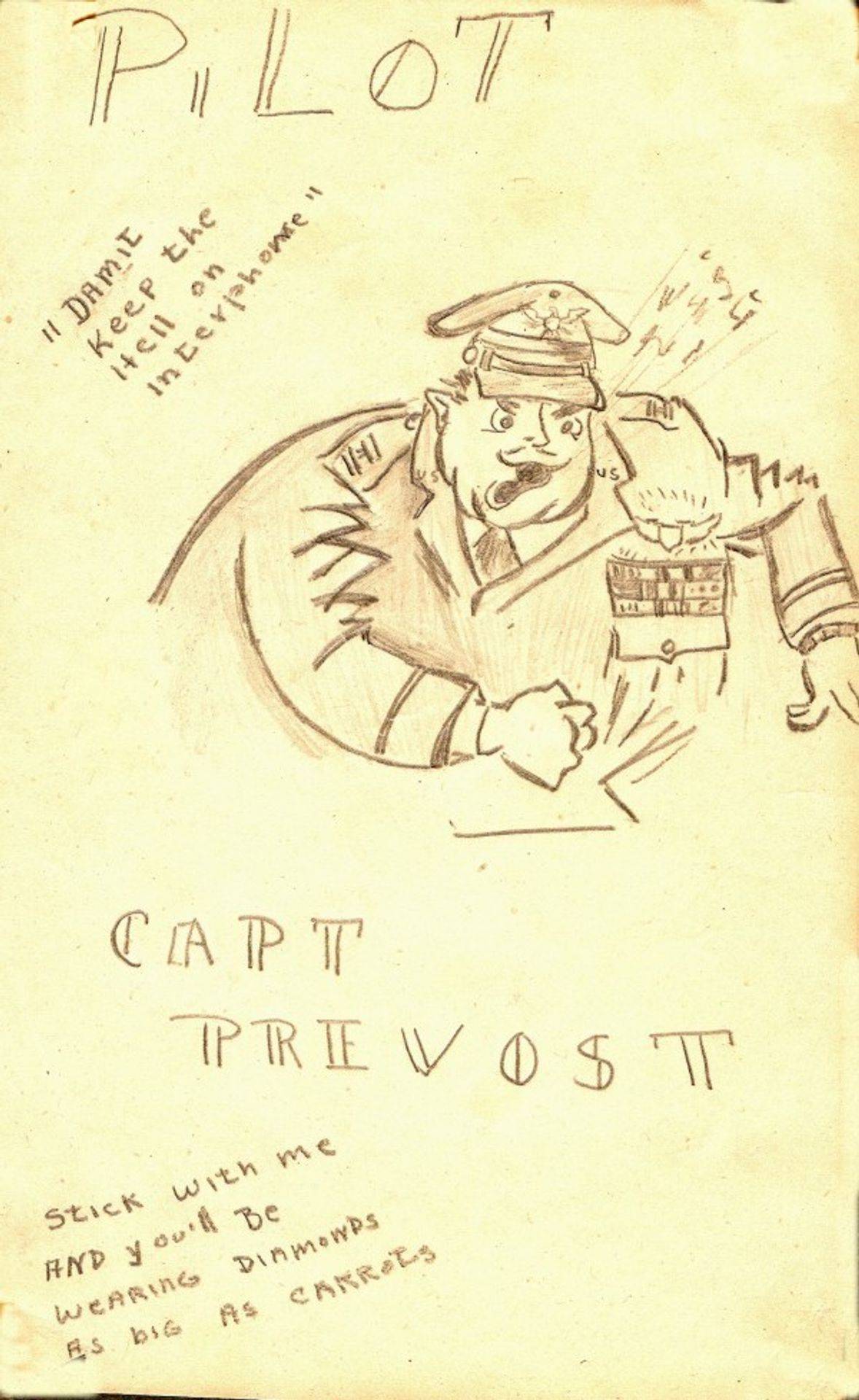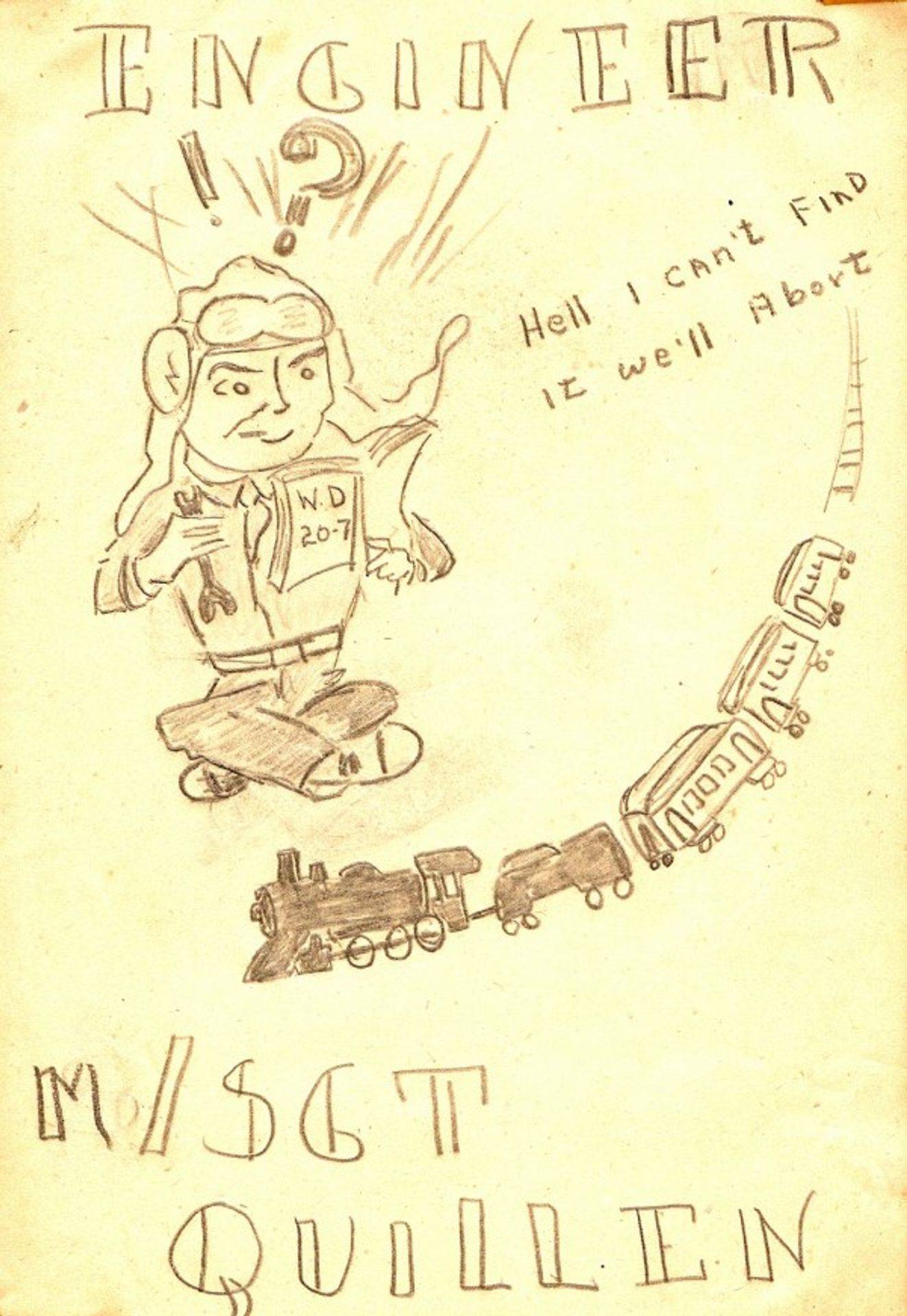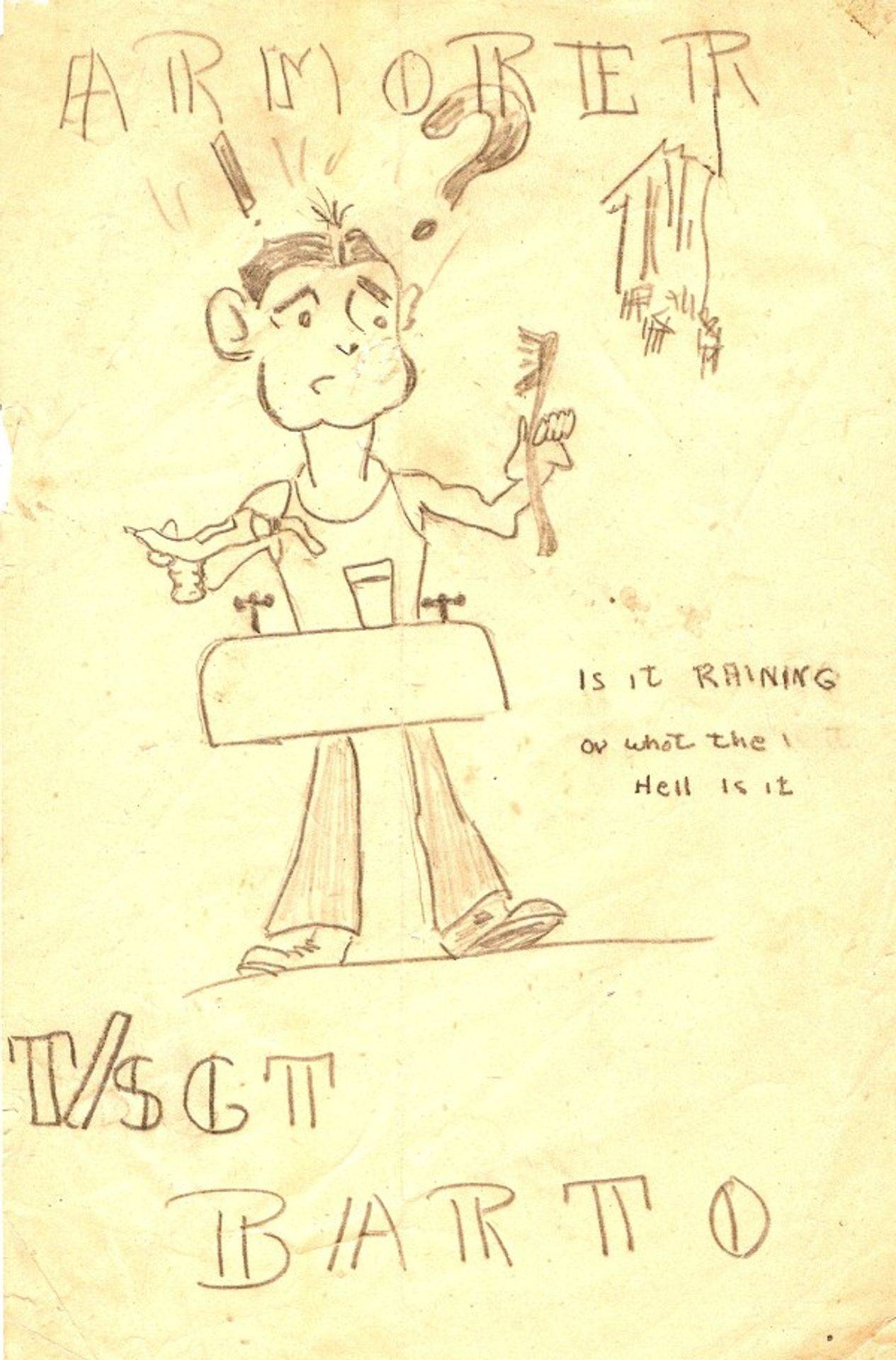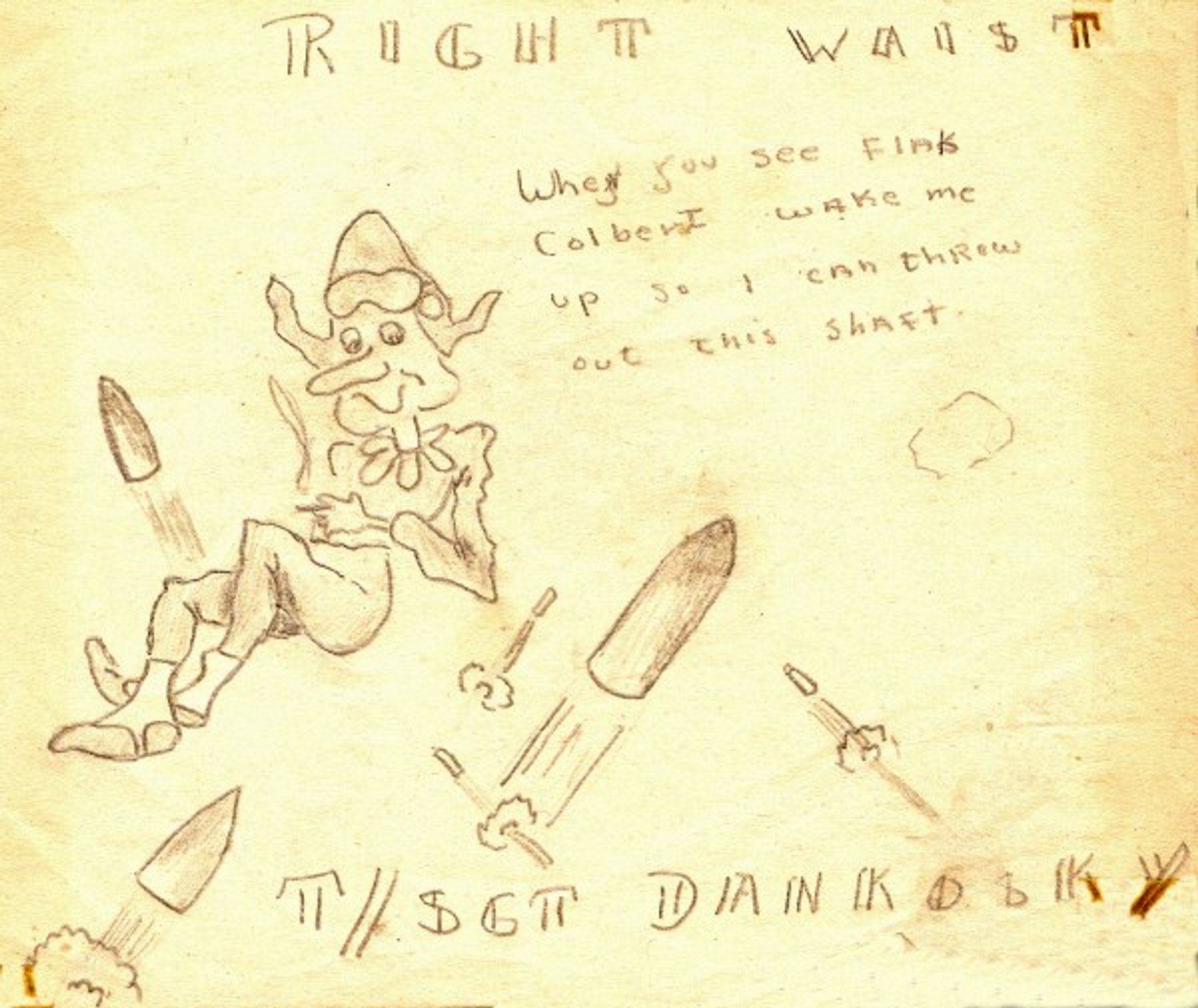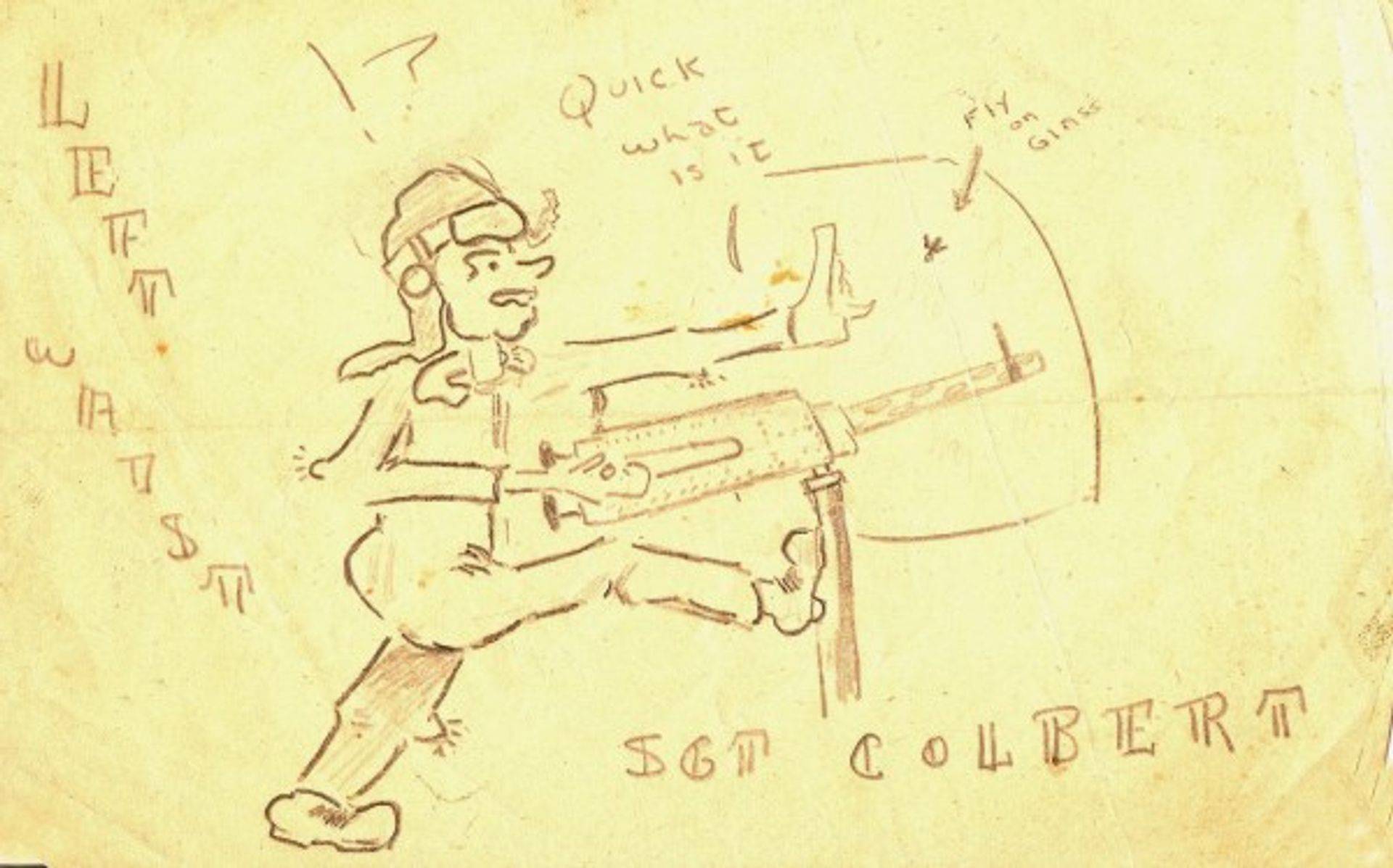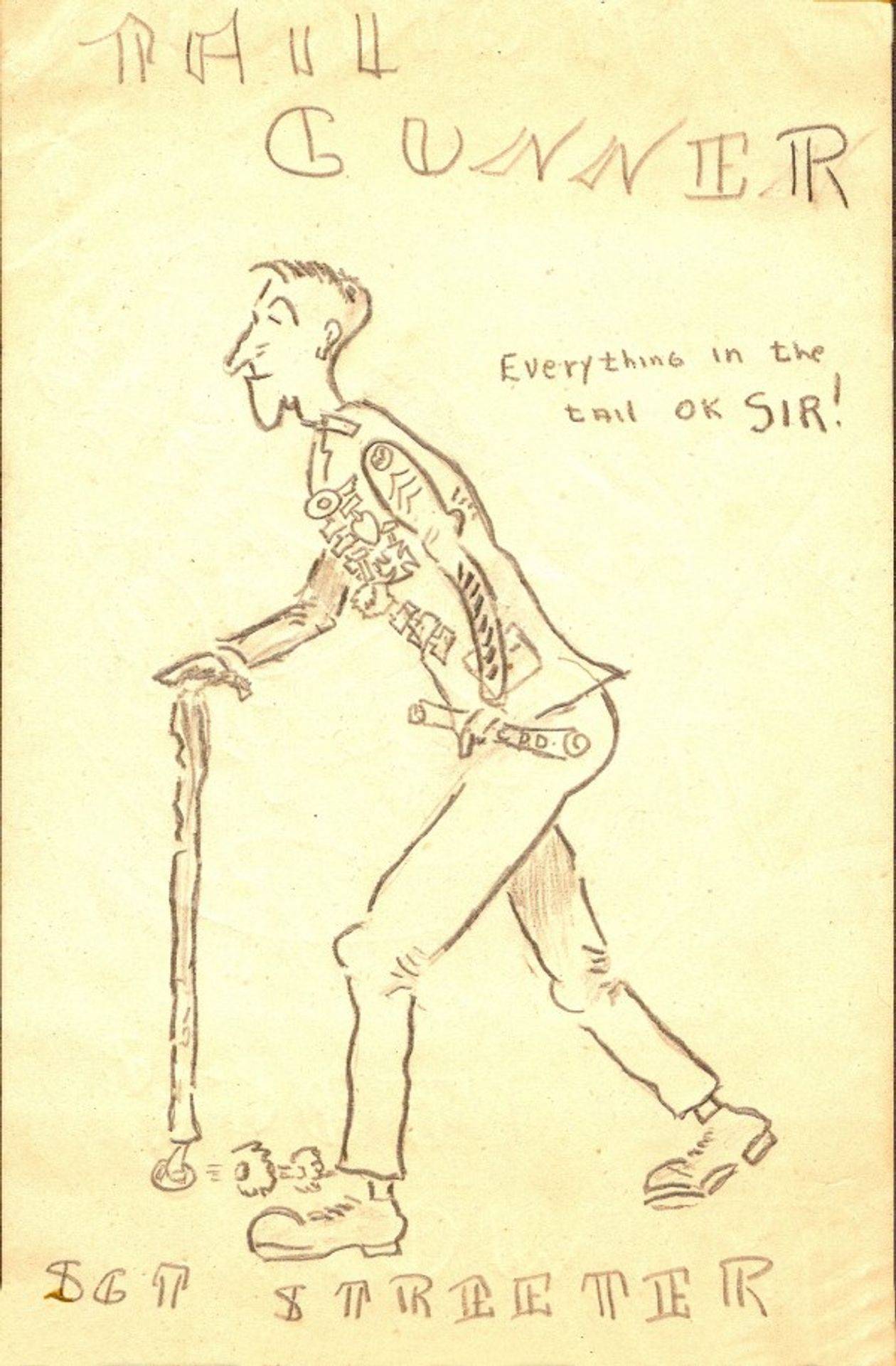Prevost Crew – Assigned 755th Squadron – July 10, 1944

Ditched in English Channel August 5, 1944 – MACR 8675
| Rank | Name | Serial # | Pos | Date | Status | Comments |
|---|---|---|---|---|---|---|
| 1Lt | James B Prevost | 0817340 | Pilot | Feb-45 | UNK | Awards - Distinguished Flying Cross |
| F/O | Allen Boorse, Jr | T62414 | Co-pilot | 05-Aug-44 | KIA | Ditched in English Channel |
| 2Lt | Astor Perry | T125261 | Navigator | 24-Jan-45 | RFS | Removed from flying status |
| F/O | Robert F Kearney | T2862 | Bombardier | 23-Oct-44 | UNK | Oct44 Trsfr to 754th Sqdn |
| S/Sgt | Henry C Howard | 35450626 | Radio Operator | 09-Nov-44 | RFS | TD to AAF 101 (Med board) |
| S/Sgt | James C Quillen | 33678333 | Flight Engineer | 23-Oct-44 | UNK | Oct44 Trsfr to 754th Sqdn |
| S/Sgt | Raymond E Barto | 13176148 | Ball Turret Gunner | 10-Feb-45 | UNK | Rest Home Leave |
| Sgt | Benjamin W Dankosky | 12228037 | Waist Gunner | 25-Dec-44 | UNK | Last mission in his log |
| Sgt | John C Colbert | 33764791 | Waist Gunner | 23-Oct-44 | UNK | Oct44 Trsfr to 754th Sqdn |
| Sgt | George E Streeter | 6997240 | Tail Turret Gunner | 23-Oct-44 | UNK | Oct44 Trsfr to 754th Sqdn |
The Prevost Crew were assigned to the 755th Squadron in July 1944. Their first mission came fairly quickly on July 16th, just six days after arriving. They were forced to abort on this first trip due to mechanical difficulties. Several other missions, mostly to Germany followed their first. Their eighth mission on August 5, 1944 would end in the crew’s ditching in the English Channel. F/O Allen Boorse, co-pilot, was lost, but the remaining nine crewmen were picked up by British Air Sea Rescue.
After spending several weeks recovering from their dunk in the Channel, the crew went back to flying combat missions. The surviving crew were all awarded the Purple Heart in August 1944. 2Lt Eugene D. O’Donnell, originally assigned with the crew of Lt Gerald Allen on August 15, 1944, became their new co-pilot. It is believed that he flew with the Prevost crew on the remainder of their missions. He is shown going on rest home leave in March 1945 and is is assumed that he completed a combat tour.
Prevost flew several Truckin’ Missions in September, but the make-up of his crew is unknown.
The crew was transferred to the 754th Squadron on October 23, 1944. Formation plans indicate that 2Lt Prevost flew only five more missions in November and December. He is shown on subsequent formation plans only twice, both times in January 1945 and both times his duties are listed as “Marshaling Chief”. It is assumed that he was removed from flying status at the end of December. Prevost was awarded the Distinguished Flying Cross in February for his actions on August 5th.
It is not known whether the rest of the crew completed their missions with another pilot or if they also came off of flying status. The only crewman known to have been removed for sure was Sgt Howard who was ordered to report to the Central Medical Board at AAF 101 in November 1944. 2Lt Perry is shown in the records as late as January 1945, and nothing is shown for F/O Kearney after being transferred to the 754BS October 23, 1944. Sgt Barto is shown going on rest home leave in February 1945, possibly having completed a combat tour. The status of the others is not known.
Missions
| Date | Target | 458th Msn | Pilot Msn | Serial | RCL | Sqdn | A/C Msn | A/C Name | Comments |
|---|---|---|---|---|---|---|---|---|---|
| 16-Jul-44 | SAARBRUCKEN | 91 | ABT | 42-95120 | M | J3 | -- | HOOKEM COW / BETTY | ELEC SYST OUT |
| 17-Jul-44 | 3 NO BALLS | 92 | 1 | 41-28719 | Q | J3 | 39 | PADDLEFOOT | |
| 19-Jul-44 | KEMPTEN | 94 | 2 | 42-95316 | N | J3 | 30 | PRINCESS PAT | |
| 20-Jul-44 | EISENACH | 95 | ABT | 42-52441 | I | J3 | -- | LAST CARD LOUIE | #2 SUPER CHG |
| 21-Jul-44 | MUNICH | 96 | 3 | 44-40288 | S | J4 | 6 | BAD GIRL | |
| 24-Jul-44 | ST. LO AREA | 97 | 4 | 44-40264 | K | J4 | 5 | KISS ME BABY | |
| 25-Jul-44 | ST. LO AREA "B" | 98 | 5 | 42-52441 | I | J3 | 43 | LAST CARD LOUIE | |
| 01-Aug-44 | T.O.s FRANCE | 100 | 6 | 42-51097 | T | J3 | 36 | UNKNOWN 022 | |
| 02-Aug-44 | 3 NO BALLS | 101 | 7 | 42-51179 | P | J3 | 26 | DUSTY'S DOUBLE TROUBLE | |
| 04-Aug-44 | ROSTOCK | 103 | ABT | 41-29359 | J | J3 | -- | TAIL WIND | #3, 4 GENERATORS |
| 05-Aug-44 | BRUNSWICK/WAGGUM | 105 | 8 | 41-29359 | J | J3 | 53 | TAIL WIND | DITCHED IN CHANNEL |
| 27-Sep-44 | HORSHAM to LILLE | TR10 | -- | 42-50290 | M | 389BG | T3 | MARTHA R. | TRUCKIN' MISSION |
| 28-Sep-44 | HORSHAM to LILLE | TR11 | -- | 42-50290 | M | 389BG | T4 | MARTHA R. | 1ST FLIGHT |
| 28-Sep-44 | HORSHAM to LILLE | TR11 | -- | 42-50290 | M | 389BG | T5 | MARTHA R. | 2ND FLIGHT |
| 30-Sep-44 | HORSHAM to LILLE | TR13 | -- | 42-100425 | O | 755 | T12 | THE BIRD | TRUCKIN' MISSION |
| 05-Nov-44 | KARLSRUHE | 142 | 9 | 42-95108 | B | Z5 | 44 | ENVY OF 'EM ALL II | |
| 08-Nov-44 | RHEINE | 144 | ABT | 42-51196 | Q | J3 | -- | THE GYPSY QUEEN | RADIO COMPASS INOP |
| 21-Nov-44 | HARBURG | 148 | 10 | 42-51179 | P | Z5 | 49 | DUSTY'S DOUBLE TROUBLE | |
| 26-Nov-44 | BIELEFELD | 150 | 11 | 42-95108 | B | Z5 | 47 | ENVY OF 'EM ALL II | |
| 18-Dec-44 | KOBLENZ | REC | -- | 42-95108 | B | Z5 | -- | ENVY OF 'EM ALL II | RECALL DUTCH ISLE |
| 25-Dec-44 | PRONSFELD | 158 | 12 | 42-95108 | B | Z5 | 49 | ENVY OF 'EM ALL II | |
| 07-Jan-45 | RASTATT | 166 | MSHL | -- | -- | -- | -- | MARSHALING CHIEF | |
| 29-Jan-45 | MUNSTER | 175 | MSHL | -- | -- | -- | -- | MARSHALING CHIEF |
Crew Statements from MACR 8675
The caricatures below were drawn by gunner Ben Dankosky, and very generously sent to me by his son LTC Michael Dankosky. These do not appear in the MACR. Click each for a larger image.
5 August 1944, our crew was on a mission to Brunswick, Germany. We were leading the low trail element, and not having any difficulty in maintaining our position. While over the target, we were on the edge of an intense flak barrage, but to the crew’s knowledge we had escaped battle damage, as I had told the crew to give the ship an inspection for damage upon leaving the target, and none was reported.
Coming out from the target, we lost our left wing man, and the No. 3 man in the lead element feathered his No. 1 engine, and dropped behind the formation. Just before reaching the enemy coast, coming out, I called the deputy leader and asked him if it would be alright for me to take the No. 3 position on the leader inasmuch as neither of us had a left wing man. He gave his approval and we promptly moved into position.
A few minutes after leaving the coast of Holland, I sent my engineer to check the amplifiers as our No. 3 and 4 manifold pressures started fluctuating. He was gone for some minutes during which time No. 3 and 4 engines had stopped altogether, and I had feathered them. We could not hold our position in formation. I called the leader informing him of our trouble and notifying him we were leaving the formation. After the engineer had returned we were successful in bringing No. 3 and 4 engines back in by turning the fuel valves on “crossfeed”, inasmuch as we were pulling excessive power despite the fact the crew had jettisoned all available material.
The radio operator had been sending SOS calls for some time. On our right there was a formation of B-24s with Orange and Black tails. I called them on VHF informing them of our situation and asking one of them to stay with us in case we had to ditch.
We were now at about 12,000 feet and cruising at 1600 RPM. I had the engineer check the gas and he reported a little over 100 gallons. We only had approximately 40 miles to go before reaching the English Coast. I felt certain we could make it without too much difficulty. Evidently there was some undisclosed battle damage to our fuel system, because not more than two minutes after checking 100 gallons of gas in the tanks all four engines stopped at one time.
I feathered all four engines to increase gliding distance, and gave the order for ditching positions.
The Co-Pilot, F/O ALLEN BOORSE, JR., and myself strapped ourselves in with the crash harness. Upon inspection, both were fastened securely. The radio operator was the only man left on the flight deck.
I put the flap at approximately 15 degrees for impact, and we hit the water at 110 to 120 MPH. The nose of the ship immediately went under water and never came up. Upon impact F/O BOORSE was still securely strapped in his seat. We had previously thrown our parachutes overboard.
I experienced some difficulty in getting out of the top hatch and could not see due to the cabin being filled with churning salt water. When I escaped I held on to the wing for about 20 minutes during which time I did not see or hear F/O BOORSE.
It is my firm belief that he was wedged in the cabin and never got out of the plane.
The Captain of the rescue ship said the area was searched extensively and all survivors were picked up.
/Signed/
JAMES B. PREVOST, 0-817340
2nd Lt., AC
We hit the water at an air speed of between 130-150 MPH. The nose and flight deck broke off and sank into the water. The Pilot, Co-Pilot, and Radio Operator were on the flight deck. After sinking into the water I pulled my “Mae West” and worked my way out the top hatch. I was in the water about ten minutes before I was picked up.
/Signed/
HENRY C. HOWARD
Sgt. 35450626
Off the coast of Belgium #1 & 2 engines stopped. The pilot called me and I climbed out of the top turret and came down to find the trouble. I went back and checked the gas in the sight gauges. #3 and 4 had about fifty gallons of gas and #1 & 2 was dry. I turned the fuel selector valves to tank to engine to cross feed on #3 and 4 engines. About two minutes later all four engines stopped. We were at 16,000 feet when the first two stopped and at 12,000 when all four engines stopped. We glided about twenty miles when we hit the water. I don’t remember much of what happened when we hit. Someone said we hit and I could see water coming in the camera hatch. But I think it was waves hitting the bottom and then I heard a loud noise and aluminum tearing. I was thrown back of the ball turret. I was under water and caught on something. I kicked myself loose and came up to the top. We were in the water from ten to fifteen minutes when we were picked up by Air Sea Rescue.
/Signed/
JAMES C. QUILLEN
Sgt. 33678335
About thirty miles from the English Coast the four engines quit. The ship glided on till we were about ten miles from the coast. Before the engines quit and after we threw out everything that could be of no further value to us and decreased the weight of the ship.
After we hit the water I do not remember anything until I was out in the water and had inflated my “Mae West”. I do remember being hung up on something for a moment. I released myself by tearing the sleeves of my suit.
I was in the water approximately ten minutes when I was picked up by a motor torpedo boat.
/Signed/
RAYMOND E. BARTO
Sgt. 13176148
When the plane got into trouble I was in the waist as Right Waist Gunner. We threw out everything loose and that could be pried loose. Then all four engines went out and we threw our parachute and harness out, for, at this time we knew it was too low to bail out.
We took ditching positions and waited for the plane to hit. After hitting I got out. I went out the left window and then back thru the broken part to the right as the plane kept blowing over. We were in the water about fifteen minutes when an Air Sea Rescue boat picked us up. Some of the fellows were picked up by a Motor Torpedo boat. We were then taken to a hospital.
/Signed/
BENJAMIN W. DANKOSKY
12228037, Sgt.
When we found out we had to ditch we started throwing everything that we could out. When the bell rang we put the safety belt across and sat in a circle prepared for the impact. I asked the engineer to join me in a prayer as that was about all we could do. We didn’t get the prayer finished when there came a terrific impact. Immediately the water seemed to have come in, putting me in a state of confusion as what was going on. When I realized I was in water I yanked my cords on my “Mae West”. I had previously blown it up by mouth and the extra air from the cylinders broke it. I struggled to the top to breathe. When my head came above the surface I breathed a sigh of relief and tried to get away from the ship.
After I struggled to stay on top for ten or fifteen minutes a ship came along side of me and the sailors threw me a rope which I tied around my wrist. I suffered a mild case of shock and a rather bruised leg that I don’t know how I got exactly. They took us to a hospital where we received very good treatment.
JOHN C. COLBERT,
Sgt. 33764791
/Signed/
After leaving enemy territory returning on our way home, our engines cut out at about 16,000 feet over the North Sea. The Pilot feathered the engines and ordered the crew to prepare to ditch. All of the crew started to remove all equipment that was movable and started throwing it overboard.
A/C glided for a long distance, and everyone was in their ditching positions. There was but one impact upon hitting the water. The metal of the ship started to rip apart and the water washed in. The nose separated from the rest of the ship and kept sinking by itself. The fuselage parted in front of the [Sperry] ball turret, about three-fourths the way up. All men were thrown out of the plane in the sea. They were in the sea about ten to fifteen minutes before we were picked up by the Air Sea Rescue boat and a torpedo boat. The men on the boat dove into the sea off of the boat and pulled the crew members into the boat. They were very nice to us and did a fine job.
The Co-Pilot did not appear after the crash. We looked around for him. All crew members were injured by cuts, bruises, and sprains.
/Signed/
GEORGE E. STREETER
Sgt. 6997240
B-24H-15-CF 41-29359 J3 J Tail Wind
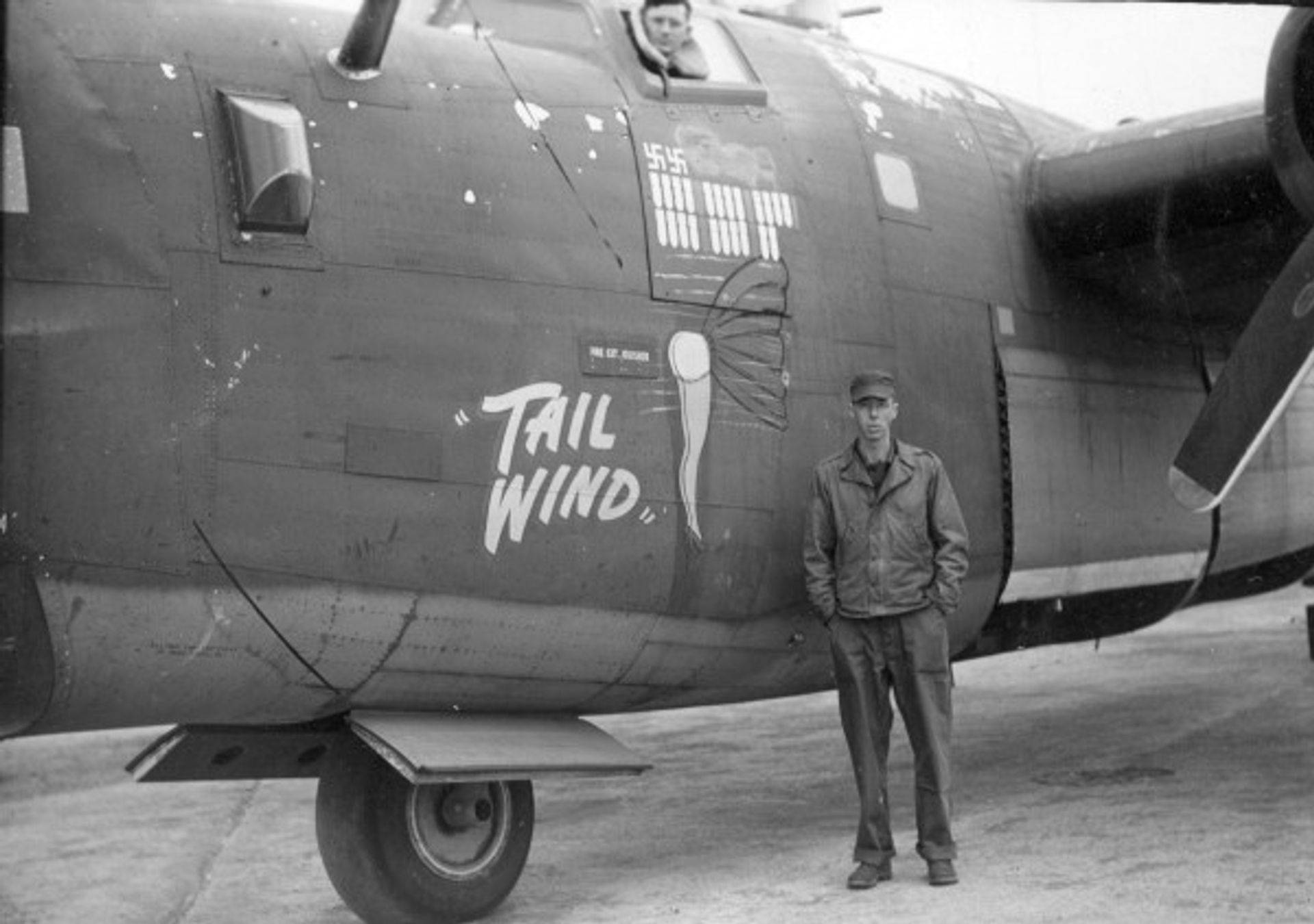
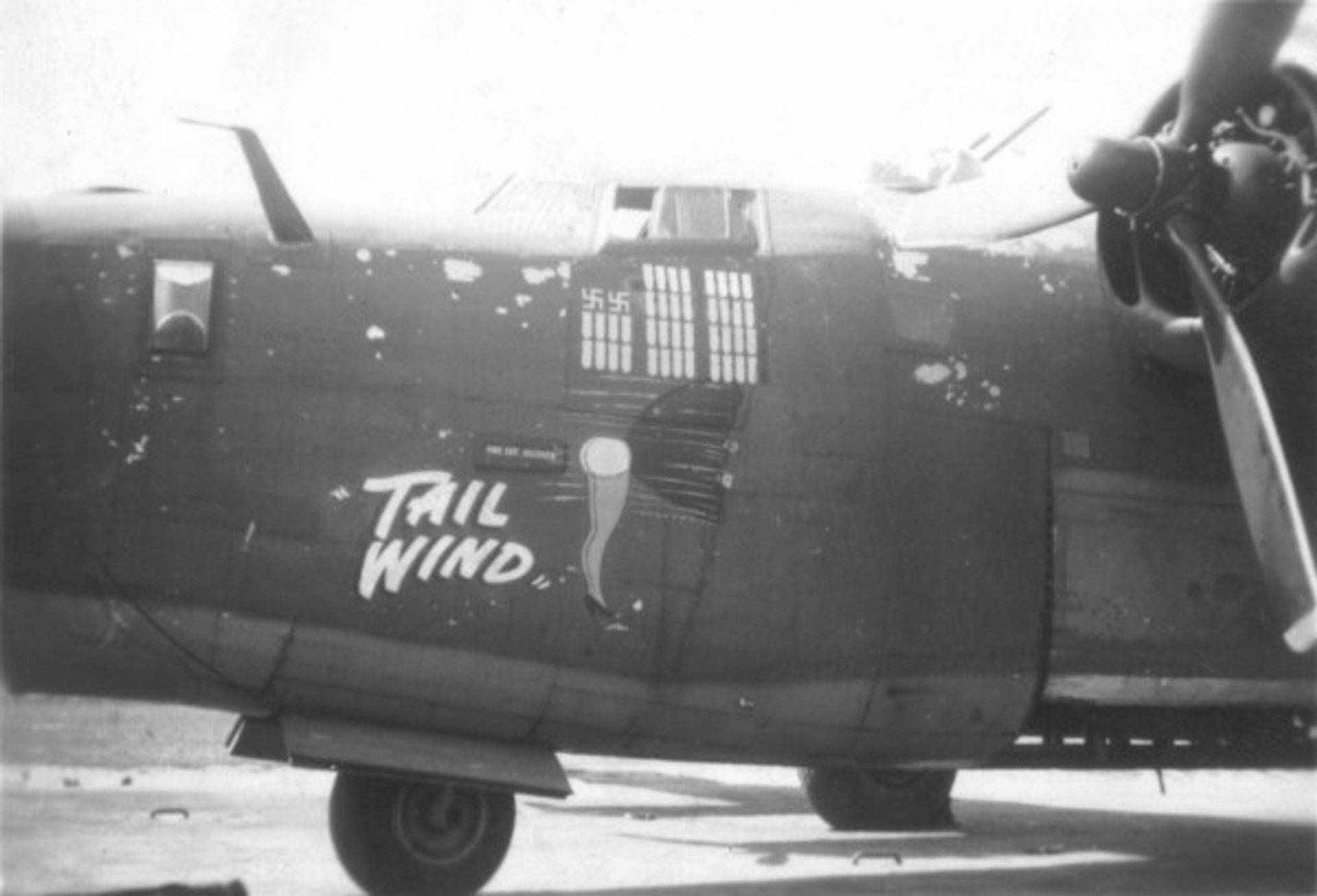
Showing about 27 missions with two unidentified men, and in late July 1944 with 50 missions on her scoreboard.
(Photos: Rick Rockiki)
Ditching of a B-24 Airplane into the James River
Experimental ditching test conducted by NASA Langley Researcher. The B-24 was ditched into the James River on September 20, 1944.
This ditching was done under the most ideal conditions imaginable – flat, calm water, a five mile per hour wind…and still this Liberator experienced severe damage. Prevost’s crew, ditching into the English Channel, under combat conditions, and with no power, would have proved much more difficult. Still, it is a most interesting piece of film done about six weeks after the Prevost crew’s ditching.
Sgt Ben Dankosky – Army Life

I enlisted in the Army Air Forces September 28, 1943 and received a serial number of 12228037. On October 18 I got on a train for Greensboro North Carolina for basic training. On December 27, after getting put in the reserve I departed for gunnery school at Tyndall Field, Panama City, Florida.
I was put in Squadron E and after two months graduated with a PFC rating February 22, 1944. I then had a ten day delay in route and four days travel time. I reported to Westover Field, Mass on March 7, 1944 and was put in the 1st Bomber Command. After two weeks in the 1st Bomber I was assigned to the R.T.V. training at Westover.
I was assigned to a combat crew on a B-24 as Asst Engineer. I took a course in this and also gunnery and aircraft recognition. I became a corporal April 29, 1944. We finished our R.T.V. training ahead of time and had a nine day furlough. I graduated from R.T.V. and was set to go overseas. On June 9, 1944 we got a train to Mitchell Field, Long Island to pick up our ship. We took off for Dow Field, Maine June 16, 1944.
On June 17, 1944 we took off for our first stop, Labrador. We landed there the same night, refueled and at 3 AM, June 18th we took off for Nutts Corner, Ireland instead of Iceland. We flew across the North Atlantic but had to land at St. Argel Field Ireland because we were low on fuel. It took us 10-1/2 hours. The town nearby was Inskillen. On June 19th we took off again and reached our destination. We then took a train to the coast and then a boat across the Irish Sea to Scotland. We then took a train to Stowe, England and got gas masks and K.P. We shipped from Stowe to Birch Field near Worthington, England.
We then flew over to Ireland and went to school at a place called Greencastle. After two weeks of school we went back to Birch Field, England and then flew to here. The place is called Norwich, England. It’s located in Southern England where all the Robot Bombs are falling, but they are doing so near London 90 miles away. We arrived here on July 11, 1944. On July 14th we were slated for our first mission but all missions were called off that day. I am assigned with the rest of my crew to Crew 62 of the 755th Bomb Sqdn 458th Bomb Group. Our tails of our planes are red with a white stripe down the middle of them. I became a Sgt. today.
Today, July 16th, we were again alerted for a mission. After tossing about for about an hour I fell asleep at 1:45 A.M. we were awakened and told breakfast at 2:00 and briefing at 2:45. We went down to briefing and was told our target for today was Saarbrucken, Germany – a railroad center. We went out to our ship and installed our guns, got our escape purse and kit. Take off time was 5:30 A.M. We took off and formed at 16,000 and gained altitude as we crossed the English Channel till we were at 22,500 feet. We were five minutes from the French Coast when our generators went out, then our batteries burnt out. With that all our electrical system went out – Interphone, bail-out bell, radio, instruments. We then started to lose altitude. We had to drop our bombs, twelve 500 pounders. We then made our field at 5,000 feet and shot red flares. The meat wagon met us but we landed OK.
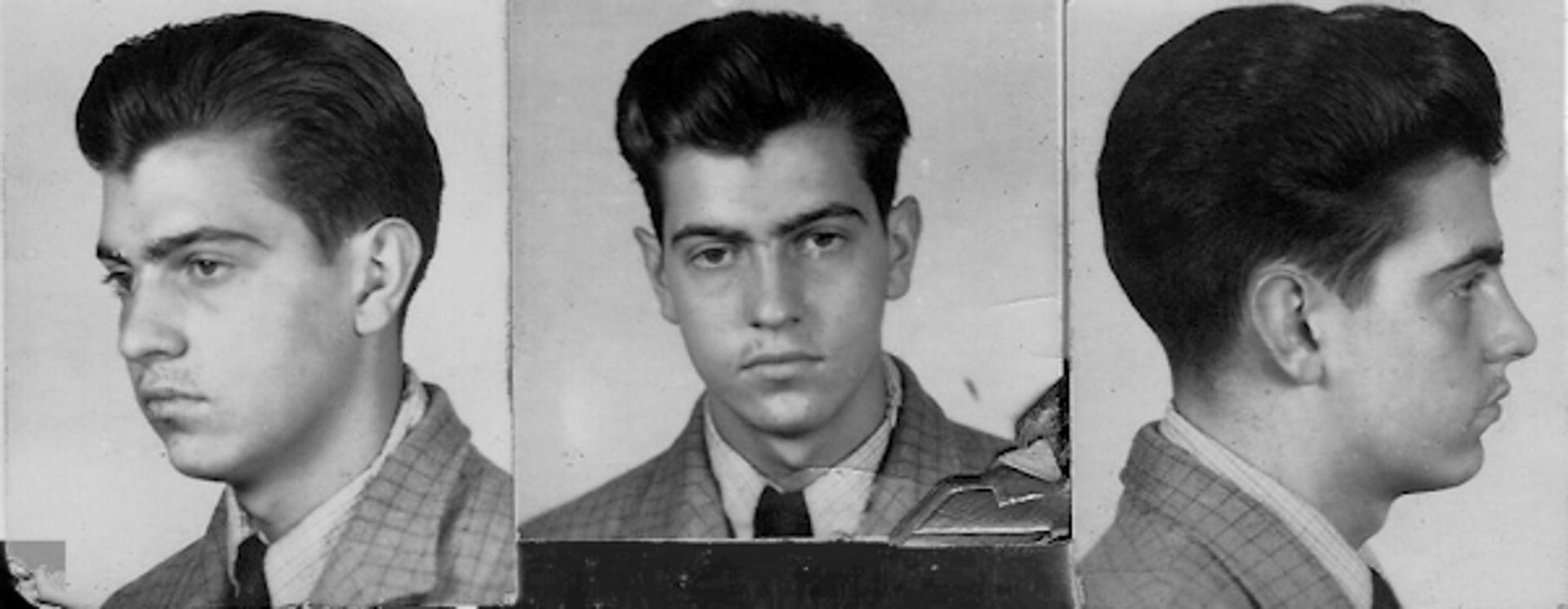
Escape Photos
July 17, 1944 – 1st Mission
We were alerted again today. Briefing at 3:15 P.M. Our target was Remaisnil Torcey-le-Grand. Just off the coast of France. We carried twelve 500 pounders. The target was a Robot Flying Bomb Plant. From the looks of it, it looks like we really demolished it. Before going over the target we threw out chaff which makes the radar equipment almost useless. There was a considerable amount of flak, but none was close. Though one burst at the wingtip and one at the tail. We saw a lone Fort [B-17] near the target and later learned that it was German.
July 18, 1944 – [Mission] Scrubbed
We were to bomb an oil refinery in Rotterdam, but it was called off.
July 19, 1944 – Mission 2
Today we went 1000 miles to go into Kempten, Germany to bomb the Messerschmitt plant which was just completed. The raid consisted of about 1000 planes. We saw a few enemy planes but we had eight squadrons of fighters and the P-51s took care of them. We also had P-47s and P-38s along. On the way back we went over Stuttgart, which is noted for its flak. Our ship had about 8 or 10 holes. The nearest was a couple of holes above my head. The flak was accurate and they were tracking us. The trip took 8 hours, 5 ½ of it being on oxygen.
July 20, 1944
The target was Eisenach where another airplane factory was located but we had engine trouble over the coast of France so we came back. The boys hit Frankfurt instead.
July 21, 1944 – Mission 3
Our target today was a Dornier airplane engine plant at Munich, Germany. It took 8 hours, 5 of which was on oxygen. We flew at 23,500 and up to 25,000 feet. It was overcast all the way over. I guess my prayers were answered. We had good fighter support of P-51s all the way in and out. There were quite a few dogfights over the target
July 24, 1944 – Mission 4 [This part of diary is partially missing]
…and the whole 8th and 9th Air Force was going to bomb a wooded section where our boys were held up. We finally got started at 9:15 for St. Lo in Normandy. There was hardly any flak at all though I’ve got a piece that I took out of the tail.
July 25, 1944 – Mission 5
Today we were sent back to St. Lo Normandy and this time drop the bombs – 52 one-hundred pounders. I should imagine that there was over a thousand. It was the longest stream of bombs that I ever saw. The flak wasn’t bad today and I guess our boys won’t have much resistance there any more. Every morning before going on a mission the Catholic chaplain comes in and says a prayer we then receive holy communion.
July 26-28 1944
We got a 2 day pass and with 8 pounds or 32 dollars, we went to London. We stayed at the Hotel Washington near Hyde Park. From a distance we saw Westminster Abby and also the Palace. We lived right off of Piccadilly. Buzz bombs or “Doodle Bugs” ads the English call them keep falling day and night with the alert or all clear screaming all the time. In some parts of the town it’s all blasted to heck, but most of it stands as before.
July 29, 1944 – Field closed in
July 30, 1944 – Went for a practice mission
July 31, 1944 – Mission 6
Today on my sisters 12th birthday I went on a mission to bomb a poison gas plant on the Rhine River at Ludwigshafen, Germany. I rode in the Martin upper turret. The flak was pretty bad. Coming back the overcast was bad and at 400 feet we missed a chimney and finally had to come down to 200 feet. I also mad the mission on which I am to be given the Air Medal but it will be awarded at a later date.
August 1, 1944 – Mission 7
Today we went over to France to a place called Bellex Son Somme with 24 x 250lb general purpose bombs, but the overcast stopped us from dropping any bombs. We saw neither enemy fighters or flak. On the way back we saw the Limeys going over.
August 2, 1944 – Mission 8
Today again we went over France to a place called Seas St. Owen with 24 x 250lb general purpose bombs and dropped them on robot sites, flak was pretty heavy. Of the four crews which we came over with, one was knocked down yesterday. That leaves three of us left.
August 3, 1944 – Day off
August 4, 1944
We aborted on account of two generators burning out and the other two couldn’t be paralleled.
August 5, 1944 – Mission 9
Today we were alerted and the target was Brunswick, Germany. The flak was intense. Everywhere you looked the sky was black. Coming back our #3 & 4 engines cut out. The engineer leveled the gas tanks. This was over the enemy coast. We had 125 miles to go. We continued on course [and] 35 miles from the English Coast all our engines went out. Just 60 seconds before we had 100 gallons of gas. We were at 14,000 feet and the pilot, Lt. Prevost, put down the flaps to glide for a B-24 is known to go straight down without engines. We were told to prepare for ditching. We glided 20 miles before hitting.
In the meantime we had thrown out our guns, ammunition, camera, flak helmets, and flak suits. I even started to throw out the oxygen bottles, but time wouldn’t allow for it. When we were too low to use our parachutes we threw out our harness and parachute too. We came down at the rate of 1500 feet a minute. The tail hit first as it should, then the nose. The nose broke off right away and sank. The pilot and radio operator got out but the co-pilot didn’t. The rest of the crew which were seven was in the waist braced against each other and the ditching belt. I was the farthest to the rear. The impact was violent, like hitting a stone wall. The water rushed in almost immediately and I did a back flip from where I was to the Sperry ball [turret] about ten feet. It was right then that the plane broke in two.
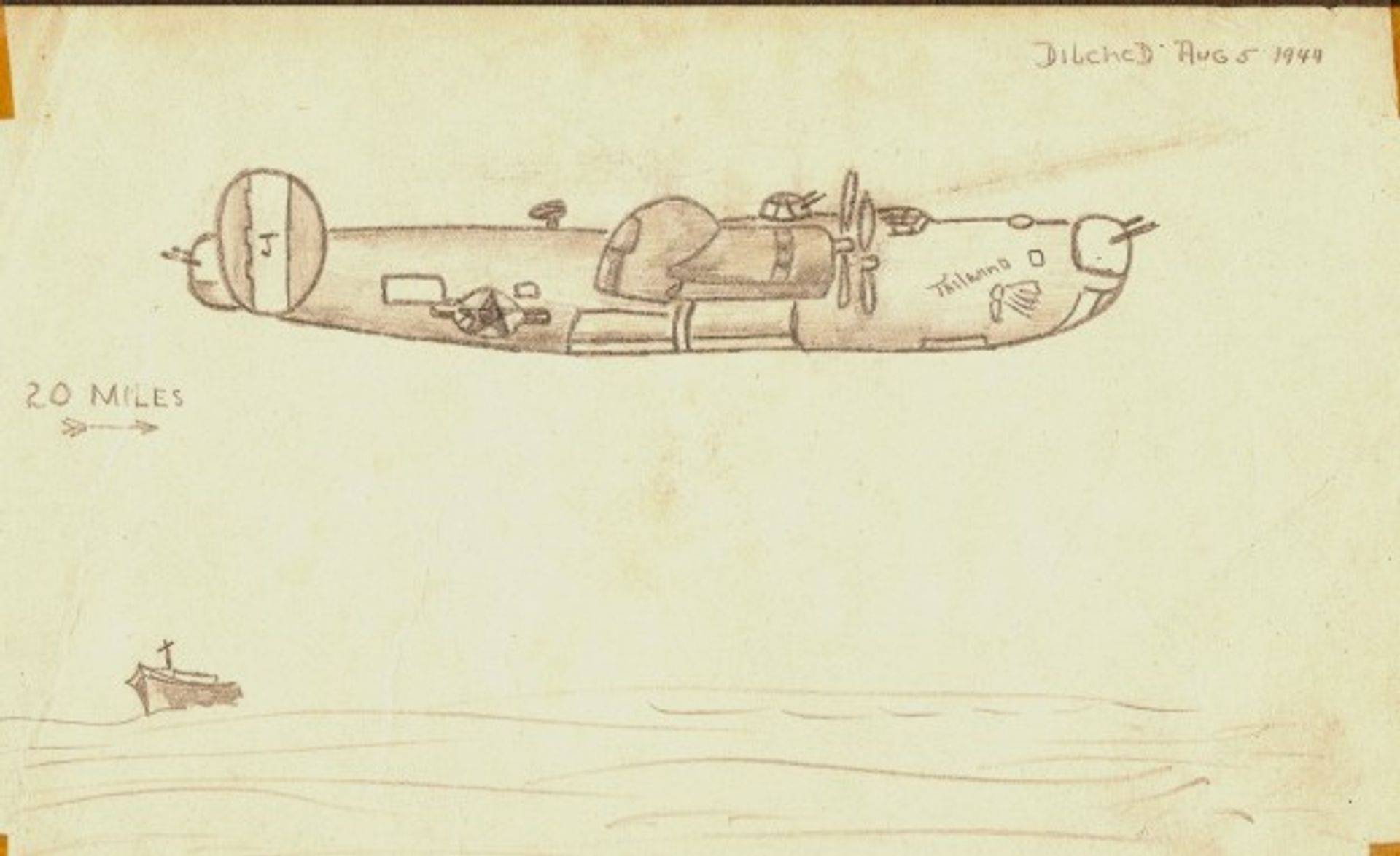
It seemed that it went a long way down, everything swirling around me. My whole life seemed to come back to me principally my mother, sister and girl and wondering what they will say as they thought that all this time I was going to school. I finally came up and got out as fast as I could before it would sink. Usually a B-24 usually only stays up 30 to 90 seconds. I grabbed a hold of an oxygen hose by the left waist and pulled myself out. The plane kept coming over on top of me so I went back through the break and went out the right side. It was there that I was grabbed by my engineer who was suffering from shock, and he tried to climb all over me. I went down a couple of times and finally, after talking to him, he calmed down and I pulled him away from the wreckage. I then pulled my life (raft) vest and it inflated.
We were then picked up by the RAF Air Sea Rescue and a motor torpedo boat. They pumped some water out of me by artificial respiration, put me on a stretcher and wrapped me up in blankets and then to the hospital. The injured are as follows from least to worst:
1. Ray Barto, ball turret – Bruises, head arm, and legs
2. Me, right waist – cuts on hand, head, legs
3. Colbert, left waist – two stitches in hand, badly bruised leg
4. G. Streeter, tail – cuts on hand, stitches
5. Perry, navigator – wrenched back
6. Prevost, pilot – cuts on face, stitches taken in hand
7. Quillen, engineer – shock, cracked rib
8. Kearney, bombardier – cuts on face 8 stitches, cuts in hand 2 stitches
9. Howard, radio operator – cuts on face stitches in 4 different places
10. Boorse, co-pilot – lost
I was later hospitalized again the next day for aeroditis[?]. We were then grounded after having stayed in the hospital for a week, and sent to a rest home for seven days. What wonderful days. Today is the first of September and we are still grounded. Today I received the Air Medal and we will get the Purple Heart soon too.
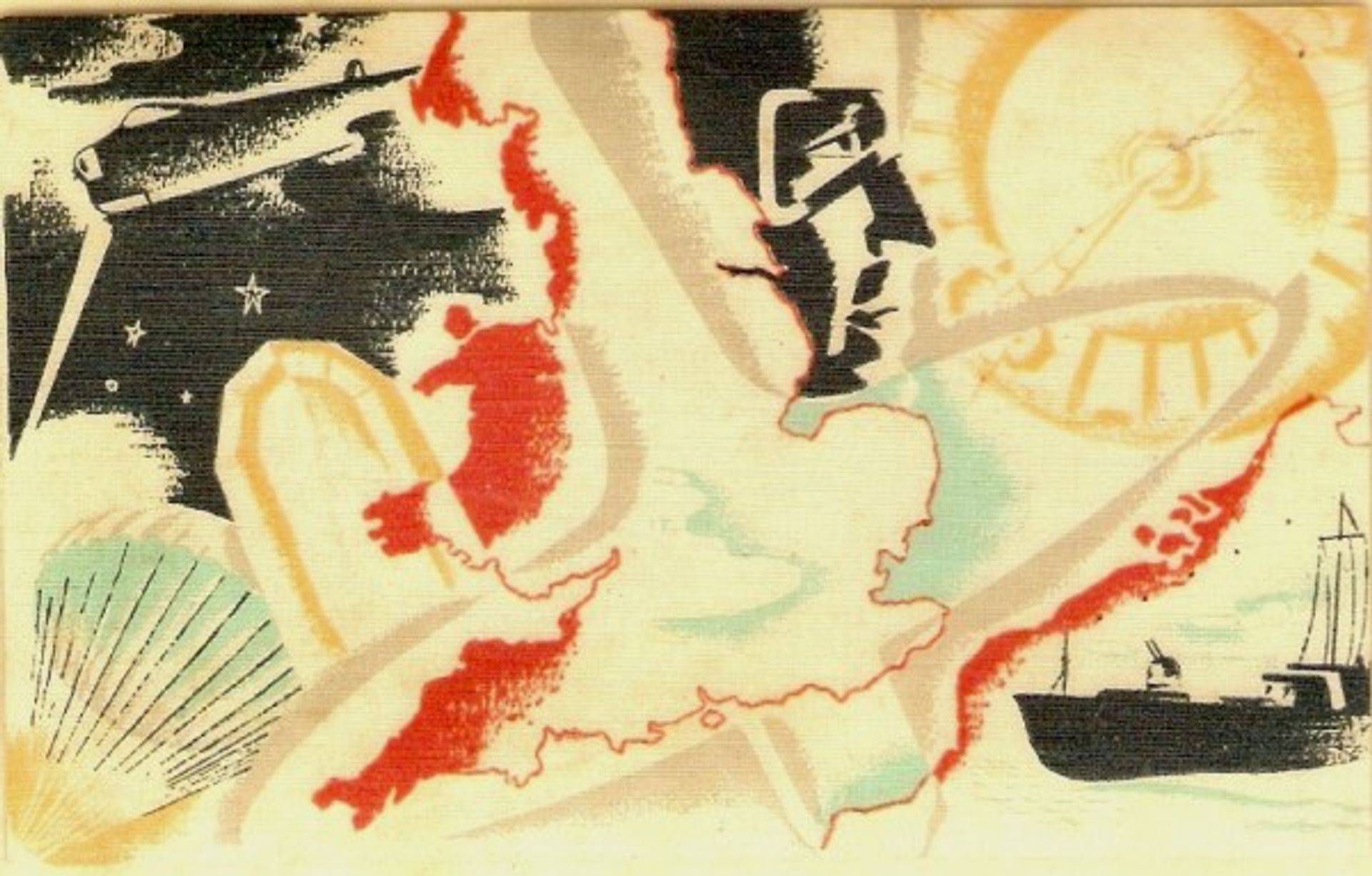

Sgt Ben Dankosky’s Goldfish Club membership card
October 13, 1944
I’ve sent my Air Medal and Purple Heart home. We have a new co-pilot whose name is O’Donnell. We had a 4-hour flight the other day and if the weather permits will have another one tomorrow. We have been transferred from the 755th to the 754th [Squadron]. Tomorrow our radio operator goes into the hospital for an operation on his nose. Last month the Jerries knocked down a whole group, the 445th. 29 out of 31 planes. Some of our boys that we came over with were in it. Two weeks later George Goodhand was killed. I can’t believe it even today. We were pretty good friends. We went through the whole army career up till now.
November 5, 1944 – Mission 10
The target was Karlsruhe which was a marshaling yard. We were one of 1200 planes. Flak was intense but just off our left wing. We had 4 two-thousand pounders. We stayed with a plane which was running low on gas. He made it OK to southern England. We had to force land at the 446th because of some fog. After it cleared we took off for our field.
November 8, 1944
We took off for a place just over the German border. The fog was so thick that we lost the formation while we were in it.
November 18-20, 1944
We went down to London on our 48 hour pass. We went to Buckingham Palace and watched the guard. We took some pictures of a circle right outside of the palace. Queen Victoria, Big Ben and Westminster Abby. It was quite dark and I dont know if they will come out. We went through Westminster Abby and looked at all of the tombs inside of it. Among the ones which are more widely known are the tombs of Gen. Howe who fought in America. Livingston, Tennyson, Robert Burns, Shakespeare, Rudyard Kipling, Thomas Hardy and a great many more.
November 21, 1944 – Mission 11
The target was Harburg which was just 6 miles out of Hamburg. We were shot at from the time we went into the coast until we left. We had quite a bit of holes in the plane. Each engine had some flak in them. The fuselage had some in it but the biggest was one which came through the bomb bay and smashed our hydraulic system. The sky was just black with flak. The worst yet.
November 26, 1944 – Mission 12 – Air Medal Cluster
The target today was a marshaling yard called Bielefeld, Germany. It wasn’t too long we had good fighter support and we didn’t see any enemy fighters or flak. The only thing that I saw that was close was a rocket bomb which just passed the waist window.
December 18, 1944
Today we were alerted to go to Koblenz to hit a round house we didn’t clear the house by much and got up we formed and started on course and into Belgium. But when we were only 25 minutes form the target we were recalled, which made us quite mad as we won’t get credit for the mission. We came back and landed. We had some excitement today though. At 6 o’clock this morning while we were still in bed the air raid alert went off. It was red which means that enemy aircraft is 20 miles away. We got talking about the different alerts. The black alert is when they’re overhead. Just then the black alert sounded. Then I heard another droning overhead. In a knowing way I said, “There it is.” One of the fellows looked out the door and sure enough there it was. It circled the field. All you could see was a big yellow ball of fire which is the rocket exhaust. Then the motor stopped and we knew that it was going to fall. We watched it and it started coming in our direction. This big yellow ball seemed to be coming straight for us. I had just gotten up to look and was still undressed except for socks so I ran I and started to put on my shoes when I see everyone tearing out of the door for the air raid shelter. I just grabbed my shoes and ran to the shelter with them. Down we went and waded through water about a foot deep. The bomb finally exploded nearby. We came up, ate and went on our mission.
December 25, 1944 – Mission 13
Today we hit Pronsfeld. We dropped the Jerries a nice Xmas present. The ground was all covered with snow. We saw part of the Siegfried Line. The ground just lit up yellow lights with the bombs exploding. That was nice to see after coming through that flak. Boy it was close.
Courtesy: LTC Michael Dankosky
Distinguished Flying Cross

GO No. 57 Hq 2AD
9 February 1945
JAMES B. PREVOST, 0-817340, First Lieutenant, Army Air Forces, United States Army. For extraordinary achievment, while serving as Pilot of a B-24 aircraft on a bombing mission to Germany, 5 August 1944. Lieutenant Prevost’s aircraft was severly damaged by intense flak just prior to bomb release. Losing large quantities of gasoline on the return trip, Lieutenant Prevost contacted Air-Sea Rescue and when his engines failed, skilfully ditched his damaged aircraft. Lieutenant Prevost’s thorough preparation and supervisory training of his crew was successful in this instance in saving the lives of nine crew members. The sound judgement and skill displayed by Lieutenant Prevost on this occasion reflect the highest credit upon himself and the Armed Forces of the United States. Entered military service from Tennessee.

